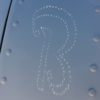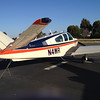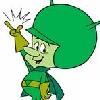09 Jun 2025, 11:34 [ UTC - 5; DST ]
|

|
Username Protected
|
Post subject: Re: Mitsubishi for first twin  Posted: Posted: 18 Jan 2015, 17:59 |
|
 |

|
|
 |

Joined: 10/27/10
Posts: 10790
Post Likes: +6891
Location: Cambridge, MA (KLWM)
Aircraft: 1997 A36TN
|
|
|
(Not an MU2 pilot)
IMO, the MU2 difference is best addressed with diligent followup checklist usage after the memory items are complete. The differences in memory items aren't severe enough (IMO) to represent a major problem.
The real issue with an MU2 as a first twin (beyond the 100 hours PIC in multi-engine aircraft SFAR requirement) is that you need to be able to think at 250+knots, understand mid-altitude weather, handle a very complex 60s-era airplane, etc.
That is possible to acquire in single-engine airplanes, and some people have done it coming from high-performance piston singles, but it's harder to jump from 150 knots to 275 knots than it is to jump from a 58P to an MU2, IMO.
Statistically, engine failure isn't what's going to kill you in a piston twin. It's even less likely to kill you in an MU2 (on a per-mile, per-hour, or per-trip basis).
Last edited on 18 Jan 2015, 18:02, edited 1 time in total.
|
|
| Top |
|
|
Username Protected
|
Post subject: Re: Mitsubishi for first twin  Posted: Posted: 18 Jan 2015, 18:10 |
|
 |

|
|

Joined: 08/18/13
Posts: 1152
Post Likes: +769
Aircraft: 737
|
|
|
I think that learning on one would be fine, but there are some things you need to keep in mind, and you'd better be competent in an IFR environment because you'll be going everywhere (pretty much) that way.
The speed isn't anything to get used to in my experience. My Solitaire is plenty fast in cruise, but it's all of 120 indicated whenever you want it to be. Actually, slow flight is so stable in a Mits you'd have to do it to believe it. It's still under roll authority in a stall.
Getting to know the environment in the flight levels is also a learning curve, but not that big of a deal. Learning to deal with ice is part of that.
As far as the OEI ops, I don't think it makes much difference what you learn first so long as you learn it correctly and stay current.
|
|
| Top |
|
|
Username Protected
|
Post subject: Re: Mitsubishi for first twin  Posted: Posted: 18 Jan 2015, 18:32 |
|
 |

|
|
 |

Joined: 11/08/12
Posts: 7372
Post Likes: +4834
Location: Live in San Carlos, CA - based Hayward, CA KHWD
Aircraft: Piaggio Avanti
|
|
Username Protected wrote: Since the procedure in a Mits is somewhat different, and since there is something to the primacy effect, I speculate that, all things being equal (which I know they are not) it might be better to just learn the peculiar Mits engine out recovery method from the beginning. My first twin was a C340, then moved to the Mits. I don't think the procedures are peculiar. In particular, FLY THE DAMN AIRPLANE, rudder for directional control, don't get slow. There is nothing "peculiar" about that and those are the critical items. Beyond that, feather and secure the bad engine, trim away control forces, FLY THE AIRPLANE. Accelerate to blue line, clean up flaps as speeds dictate. These basics are reasonably common to both. Here are differences: - with NTS, feathering the prop is less time critical - no bank into the good engine, just fly wings level - may not want to raise flaps immediately, depends on speeds. Mits can climb OEI with flaps (though not gear), sometimes better. - with any turboprop, identifying the bad engine requires more care due to possible failure in high power - dead foot/dead engine may not be correct In my experience, these are not huge differences. Biggest difference is simply speed at which things happen when stepping up. Single to Mits is a big jump due to performance differences and being used to the training regime.
_________________
-Jon C.
|
|
| Top |
|
|
Username Protected
|
Post subject: Re: Mitsubishi for first twin  Posted: Posted: 18 Jan 2015, 19:09 |
|
 |

|
|

Joined: 06/09/09
Posts: 4438
Post Likes: +3304
Aircraft: C182P, Merlin IIIC
|
|
Username Protected wrote: We were discussing twin engine flying at our BT lunch today and Randy's MU2 came up. Whenever MU's come up there is always some discussion of the the SFAR and the fact that the Mits flies "different".
I didn't get to to ask Joe Sasser, and he would have an expert opinion if anyone would, but I was wondering whether learning to fly twins in a Mitsubishi might impact the odds of a successful outcome in an engine loss situation. Since the procedure in a Mits is somewhat different, and since there is something to the primacy effect, I speculate that, all things being equal (which I know they are not) it might be better to just learn the peculiar Mits engine out recovery method from the beginning.
What say you? If your goal is to move up to a turbine at some point then don't waste one minute on a piston twin. You do whatever it takes to get safe and competant in the Mits. If you are not sure then go do the course at SIMCOM and rent an MU2 to fly with a mentor for a bit before you buy. By the time your done your mentor should be able to tell you if you are OK to go. Not everyone is OK which is why I like the train and fly approach for a person making such a step up. When I moved up I took this approach and it served me well. I almost bought a very nice Merlin IIIB that was for sale because the owner was told by his instructors and mentors that he would never fly it single pilot. He sold the Merlin and bought a PC12 and his mentors said that they also worried about how that was going to turn out.
|
|
| Top |
|
|
Username Protected
|
Post subject: Re: Mitsubishi for first twin  Posted: Posted: 18 Jan 2015, 19:14 |
|
 |

|

|
 |


Joined: 07/11/11
Posts: 1671
Post Likes: +465
Location: Redwood City, CA (KPAO)
Aircraft: 1967 Bonanza V35
|
|
Username Protected wrote: We were discussing twin engine flying at our BT lunch today and Randy's MU2 came up. Whenever MU's come up there is always some discussion of the the SFAR and the fact that the Mits flies "different".
I didn't get to to ask Joe Sasser, and he would have an expert opinion if anyone would, but I was wondering whether learning to fly twins in a Mitsubishi might impact the odds of a successful outcome in an engine loss situation. Since the procedure in a Mits is somewhat different, and since there is something to the primacy effect, I speculate that, all things being equal (which I know they are not) it might be better to just learn the peculiar Mits engine out recovery method from the beginning.
What say you? If your goal is to move up to a turbine at some point then don't waste one minute on a piston twin. You do whatever it takes to get safe and competant in the Mits. If you are not sure then go do the course at SIMCOM and rent an MU2 to fly with a mentor for a bit before you buy. By the time your done your mentor should be able to tell you if you are OK to go.
I think that makes sense, but AFAIK you will have to pay a CFI for 100 hours of dual in the MU2, over and above whatever it takes you to get your ME rating, before you can solo or take passengers in it, if you start with zero ME PIC time.
It's a big step, so plenty of time with a CFI mentor pilot is a good thing, but 100 hours is a lot.
|
|
| Top |
|
|
Username Protected
|
Post subject: Re: Mitsubishi for first twin  Posted: Posted: 18 Jan 2015, 19:31 |
|
 |

|
|

Joined: 06/09/09
Posts: 4438
Post Likes: +3304
Aircraft: C182P, Merlin IIIC
|
|
|
The mentor time will be dictated by insurance I suppose. I know people that went from piston single bush plane to twin turbine with no mentor time limitations.
BUT, if it takes 100 hours then it takes 100 hours. Irrelevant in the big scheme of things.
|
|
| Top |
|
|
Username Protected
|
Post subject: Re: Mitsubishi for first twin  Posted: Posted: 18 Jan 2015, 20:02 |
|
 |

|
|
 |

Joined: 10/27/10
Posts: 10790
Post Likes: +6891
Location: Cambridge, MA (KLWM)
Aircraft: 1997 A36TN
|
|
The 100 hours thing comes from the SFAR. Username Protected wrote: [One can log PIC time] When the pilot is the sole manipulator of the controls of an aircraft for which the pilot is rated It's not clear to me that one is rated for the MU2. One is rated for the MU2 class and category, but does the SFAR supersede that and make one not rated for the aircraft? I'd think it does. That also assumes you could find a DPE who would administer an initial multi ride in an MU2.
|
|
| Top |
|
|
Username Protected
|
Post subject: Re: Mitsubishi for first twin  Posted: Posted: 18 Jan 2015, 20:08 |
|
 |

|
|
 |

Joined: 09/16/10
Posts: 9008
Post Likes: +2064
|
|
Username Protected wrote: If your goal is to move up to a turbine at some point then don't waste one minute on a piston twin. I like the sound of that advice!
_________________
Education cuts, don't heal.
|
|
| Top |
|
|
Username Protected
|
Post subject: Re: Mitsubishi for first twin  Posted: Posted: 18 Jan 2015, 20:46 |
|
 |

|
|
 |

Joined: 10/10/10
Posts: 676
Post Likes: +490
Aircraft: C441 Conquest II
|
|
|
Just to add a couple of points. The MU-2 isn't particularly hard to fly engine out, it is just different than most other twin propeller planes (piston or turbine). You fly a King Air engine out the same way you fly a Seneca. You fly an MU-2 engine out the way you fly a jet. If you were to learn and earn your multi in an MU-2 and then flew another prop twin, you might be surprised at how violent the loss of an engine is (especially at takeoff power) -- the MU-2 would have been much easier by comparison (due to the NTS system). On the other hand, once you lose that engine, your control responses are like a jet (neutralize the yoke, rudder, roll trim) vice in other twin prop planes where you bank with the yoke.
Now as to learning and getting your ME rating in an MU-2, don't think you could do it. You need 100 hours multi PIC team to qualify for the MU-2 SFAR to act as PIC of an MU-2. If you don't have any other twin time, you will never have the PIC time. Even if you have a multi-engine rating, when you do your initial training in the MU-2, the time counts as dual, NOT PIC until you complete the training and pass your check ride. This is similar to a plane requiring a type rating. You can't log PIC time if you are not qualified to fly the plane...and just having a Multi-Engine rating does NOT qualify you to act as PIC of an MU-2.
Hope this helps.
|
|
| Top |
|
|
Username Protected
|
Post subject: Re: Mitsubishi for first twin  Posted: Posted: 18 Jan 2015, 20:48 |
|
 |

|
|


Joined: 12/03/14
Posts: 20303
Post Likes: +25441
Company: Ciholas, Inc
Location: KEHR
Aircraft: C560V
|
|
|
I transitioned from a T210L to an MU2.
I have 800+ hours in an MU2 now. I have 13 hours in other multiengine airplanes, 10 of which were in a Seminole to get the ME rating at ATP.
Lots of things to comment about in this thread, but let me deal with one at a time.
The SFAR requires that you have LOGGED 100 hours PIC twin time before you can ACT as PIC in an MU2.
If you fly with a mentor or contract pilot, they can ACT as PIC while you LOG it.
Thus the strategy for the new ME pilot is as follows:
1. Get ME rating. Doesn't matter where that much, ATP's 10 hour course (which I did in two days) is fine and was actually pretty good.
2. Get the MU2 SFAR initial IN THE AIRPLANE (which I recommend anyway over using the sim). During the entire process, you can LOG PIC time as the sole manipulator of the controls. The instructor is ACTING as PIC, you are LOGGING PIC.
3. Hire mentors (good idea), contract pilots (okay), or fly right seat with other MU2 pilots (good, too) until you have 100 hours LOGGED as PIC. Be the "human autopilot" and manipulate the "controls" during this time. The other pilot is ACTING as PIC, you are LOGGING PIC.
With SFAR training and 100 hours logged, you may now ACT as PIC. That means you can fly solo.
When I soloed my MU2, I had 90 hours in type and 103 hours in twins. I wasn't technically under SFAR rules (officially came into effect in 2009, this was 2008), but I met the rules anyway. Of my 100 hours, 40 were copiloting with other MU2 owner pilots, 30 were mentoring. For someone not ME rated, flying 100 hours with someone is a good idea, IMO. A certain amount of operational exposure is very good before you are out on your own.
I've had potential new MU2 pilots think they need to rent a piston twin and go fly it for 100 hours before they can start SFAR training. That is not only untrue, but also builds the wrong thought processes and knowledge for flying the MU2.
The "100 hour" rule in the SFAR is very stupid, IMO. There's nothing a pilot learns from 100 hours of piston time that helps that much at turbine speeds and power. Indeed, some piston habits have to be untrained, the primary one is the tendency to grab levers too damn quick or to use dead foot, dead engine instead of engine gauges.
Mike C.
_________________
Email mikec (at) ciholas.com
|
|
| Top |
|
|
Username Protected
|
Post subject: Re: Mitsubishi for first twin  Posted: Posted: 18 Jan 2015, 21:05 |
|
 |

|
|


Joined: 12/03/14
Posts: 20303
Post Likes: +25441
Company: Ciholas, Inc
Location: KEHR
Aircraft: C560V
|
|
Username Protected wrote: - with NTS, feathering the prop is less time critical My favorite exercise for new or wannabe MU2 pilots in the sim is to tell them they can't feather the engine at all. Their ONLY task is to FLY THE AIRPLANE. The purpose of the exercise is to emphasize that feathering the prop is NOT the most important thing to do in a TPE331 airplane, the most important thing is to FLY THE AIRPLANE. For the piston twin pilots, this is eye opening. It takes a while to train out their reflex to grab levers and pull them. They then fly away without feathering. Only after they have the plane securely under control, THEN do identify and feather, SLOWLY and CORRECTLY. For what I can tell, feathering the engine is about 150 FPM in climb. That's all. The NTS system has taken care of the majority of the drag from a windmilling prop. Quote: - no bank into the good engine, just fly wings level Been some argument about that lately, but I still do wings level, ball centered OEI. Quote: - may not want to raise flaps immediately, depends on speeds. Mits can climb OEI with flaps (though not gear), sometimes better. The MU2 flies more like a jet. On a jet, you don't retract flaps OEI right away, you wait until you hit certain speeds. Same with the MU2. If you have an engine fail at 120 KIAS and you pull the flaps up, you are in trouble. Go flaps 5 at 130, flaps 0 at 140 to 150. Quote: - with any turboprop, identifying the bad engine requires more care due to possible failure in high power - dead foot/dead engine may not be correct This catches the piston twin pilots who use the dead foot, dead engine routine. Fly the airplane, then carefully examine the engine gauges. Sometimes the failed engine is the one making MORE power. Mike C.
_________________
Email mikec (at) ciholas.com
|
|
| Top |
|

|
You cannot post new topics in this forum
You cannot reply to topics in this forum
You cannot edit your posts in this forum
You cannot delete your posts in this forum
You cannot post attachments in this forum
|

Terms of Service | Forum FAQ | Contact Us
BeechTalk, LLC is the quintessential Beechcraft Owners & Pilots Group providing a
forum for the discussion of technical, practical, and entertaining issues relating to all Beech aircraft. These include
the Bonanza (both V-tail and straight-tail models), Baron, Debonair, Duke, Twin Bonanza, King Air, Sierra, Skipper, Sport, Sundowner,
Musketeer, Travel Air, Starship, Queen Air, BeechJet, and Premier lines of airplanes, turboprops, and turbojets.
BeechTalk, LLC is not affiliated or endorsed by the Beechcraft Corporation, its subsidiaries, or affiliates.
Beechcraft™, King Air™, and Travel Air™ are the registered trademarks of the Beechcraft Corporation.
Copyright© BeechTalk, LLC 2007-2025
|
|
|
|



